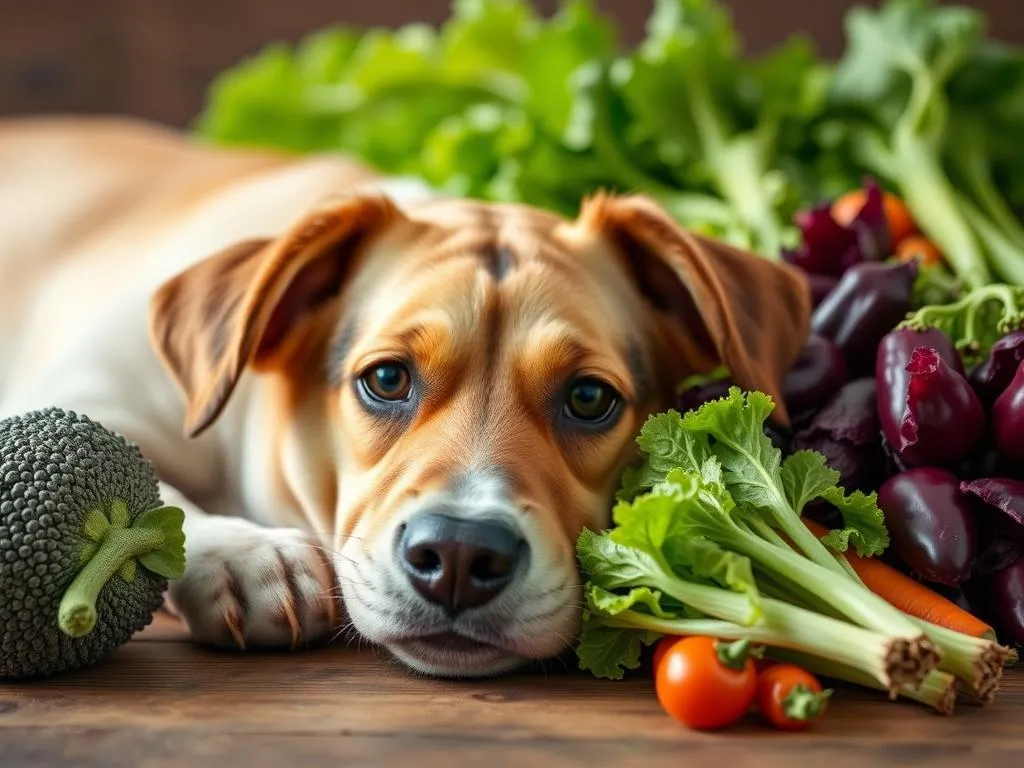
Introduction
Proper dog nutrition is vital for maintaining your furry friend’s overall health and well-being. Just as humans benefit from a balanced diet rich in nutrients, dogs require a variety of foods to support their growth, energy, and vitality. Among these foods, vegetables play an important role. Understanding what vegetables can dogs eat safely is crucial for dog owners who wish to incorporate healthy options into their pets’ diets. This article serves as a comprehensive guide to help you navigate the world of canine-safe vegetables, ensuring your dog enjoys a nutritious and balanced diet.
Understanding Canine Nutrition
The Role of Nutrition in Dog Health
A balanced diet for dogs consists of essential nutrients, including proteins, fats, carbohydrates, vitamins, and minerals. Each of these components serves a unique purpose. Proteins are vital for growth and repair, while fats provide energy and support healthy skin and coat. Carbohydrates offer a source of quick energy and aid in digestion. Vitamins and minerals help regulate various bodily functions, ensuring your dog maintains optimal health.
The Importance of Vegetables in a Dog’s Diet
Incorporating vegetables into your dog’s diet can provide numerous benefits. Vegetables are rich in fiber, which aids in digestion and promotes a healthy gut. They are also packed with vitamins and antioxidants that support the immune system. Additionally, vegetables can help complement commercial dog foods by offering variety and enhancing nutritional value. Choosing the right vegetables for your dog can lead to a healthier, happier pet.
Safe Vegetables for Dogs
Leafy Greens
Spinach is a nutrient-dense leafy green that can be beneficial for dogs. It contains vitamins A, C, and K, along with iron and antioxidants. However, it’s essential to serve spinach in moderation, as excessive amounts can lead to health issues related to oxalates.
Kale is another leafy green that can be safely fed to dogs. It’s high in vitamins and minerals but should be prepared properly. Cooking kale can help reduce its oxalate content and make it easier for dogs to digest.
Root Vegetables
Carrots are a popular choice among dog owners. They are low in calories and high in fiber, making them an excellent snack for dogs. Raw or cooked, carrots can be served in bite-sized pieces or even blended into homemade dog food. The ideal serving size varies depending on your dog’s size, but a few baby carrots or half a regular carrot should suffice.
Sweet Potatoes are another nutritious option. They are rich in vitamins A, C, and B6 and are a great source of fiber. Sweet potatoes can be boiled, baked, or mashed, making them a versatile addition to your dog’s diet. Just be sure to serve them in moderation and avoid adding any seasoning.
Cruciferous Vegetables
Broccoli is a healthy cruciferous vegetable that can benefit dogs. It is high in vitamins K and C, as well as fiber. However, it should be served in small amounts, as it can cause gas in some dogs. Steamed broccoli is often the best way to serve it, retaining nutrients while making it more palatable.
Cauliflower can also be included in your dog’s diet. It offers similar benefits to broccoli and can be served raw or cooked. Just like with broccoli, moderation is key to prevent digestive upset.
Other Common Vegetables
Peas are a great vegetable to include in your dog’s diet. They are high in protein, fiber, and various vitamins. You can serve them fresh or frozen, making them an easy addition to meals.
Green Beans are another healthy option. They are low in calories and high in fiber, making them a great treat for overweight dogs. Fresh or steamed green beans can be added to your dog’s food or served as a crunchy snack.
Zucchini is a low-calorie vegetable that can be beneficial for dogs. It is high in vitamins A and C and can be served raw or cooked. When preparing zucchini, be sure to slice it into small pieces to prevent choking.
Vegetables to Avoid
Toxic Vegetables
Onions are highly toxic to dogs and should never be fed to them. They can damage red blood cells, leading to anemia. Symptoms of onion toxicity can include weakness, vomiting, and lethargy.
Garlic is another vegetable to avoid. While small amounts may not be immediately harmful, garlic can cause similar effects as onions when consumed in larger quantities. It’s best to steer clear of garlic altogether.
Other Vegetables to Avoid
Mushrooms can be tricky, as some varieties are safe for dogs, while others are highly toxic. It’s best to avoid feeding mushrooms unless you can confirm they are safe. Always err on the side of caution and consult your veterinarian if you’re unsure.
Tomatoes can be safe for dogs once fully ripe, but the green parts of the plant, including leaves and stems, are toxic. If you choose to feed your dog tomatoes, ensure they are ripe and serve them in moderation.
Potatoes should be served with caution. While cooked potatoes can be safe, raw potatoes are toxic due to their solanine content. Always ensure that potatoes are thoroughly cooked and served without seasoning.
Preparing Vegetables for Dogs
Cooking Methods
When preparing vegetables for your dog, cooking methods can significantly impact their nutritional value. Steaming is often the best option, as it helps retain most nutrients while softening the vegetables for easier digestion. Boiling can cause some nutrient loss, so it’s less preferred but still acceptable.
Raw vegetables can be beneficial, but they may not be suitable for all dogs. Some dogs digest raw foods better than others, and it’s essential to monitor your pet’s reaction when introducing raw vegetables.
Portion Control and Serving Sizes
Determining the right amount of vegetables for your dog depends on their size, activity level, and overall diet. A general rule of thumb is to make vegetables no more than 10% of your dog’s daily caloric intake. For larger dogs, a cup of vegetables may be appropriate, while smaller dogs might only need a few tablespoons. Always observe your dog for any signs of digestive issues, such as diarrhea or gas, and adjust servings accordingly.
Incorporating Vegetables into Your Dog’s Diet
Mixing Vegetables with Dog Food
One of the easiest ways to introduce vegetables into your dog’s diet is by mixing them with their regular dog food. Chopping or pureeing vegetables and adding them to kibble or wet food can enhance the meal and make it more appealing.
Homemade Dog Food Recipes
Creating homemade dog food allows you to control the ingredients and ensure your dog is getting a nutritious meal. Here are a couple of simple recipes that include safe vegetables:
-
Vegetable Mash: Boil and mash sweet potatoes, carrots, and peas together. Serve as a side dish or mix it into your dog’s regular food.
-
Chicken and Veggie Stew: Cook diced chicken breast with chopped carrots, green beans, and zucchini in low-sodium chicken broth. Allow to cool before serving.
Monitoring Your Dog’s Reaction
When introducing new vegetables, it’s crucial to monitor your dog’s behavior and health. Look for any changes in energy levels, coat condition, or digestive health. If you notice any adverse reactions, consult your veterinarian for guidance.
Frequently Asked Questions (FAQs)
Can all dogs eat the same vegetables?
Not all dogs can eat the same vegetables. Individual dogs may have different sensitivities or allergies. Always introduce new foods gradually and consult your veterinarian if you have concerns.
How often should I feed my dog vegetables?
Vegetables can be given as treats or mixed into meals several times a week. However, they should not replace a balanced dog food diet. Aim for vegetables to make up about 10% of your dog’s daily caloric intake.
What should I do if my dog has an adverse reaction to a vegetable?
If your dog shows any signs of an adverse reaction, such as vomiting, diarrhea, or lethargy, discontinue feeding the vegetable immediately and consult your veterinarian.
Conclusion
Including vegetables in your dog’s diet can provide numerous health benefits, from improved digestion to enhanced immune support. By understanding what vegetables can dogs eat and how to prepare them safely, you can ensure your pet enjoys a balanced and nutritious diet. Always remember to consult your veterinarian for personalized advice and to monitor your dog’s response to any new foods. A well-fed dog is a happy dog, and with the right knowledge, you can contribute to your furry friend’s health and happiness effectively.









